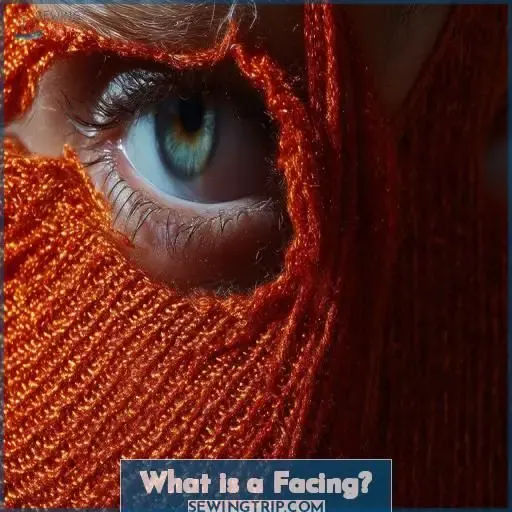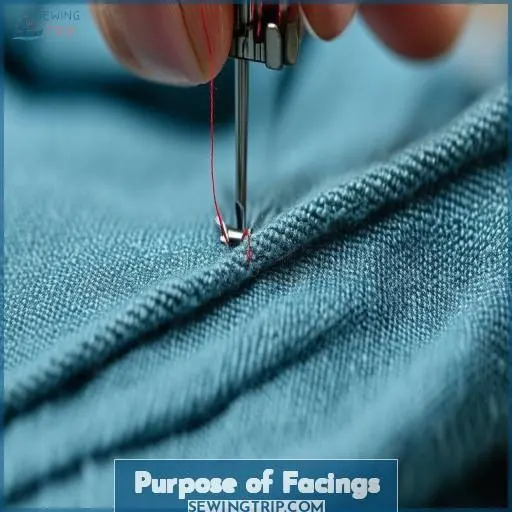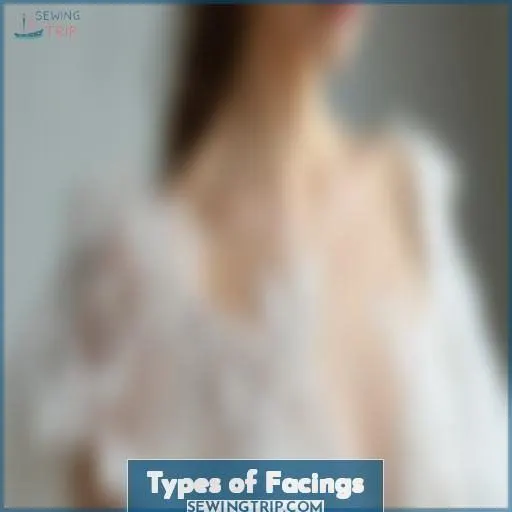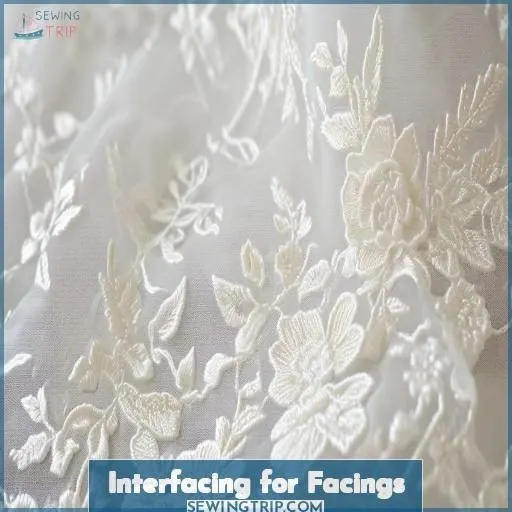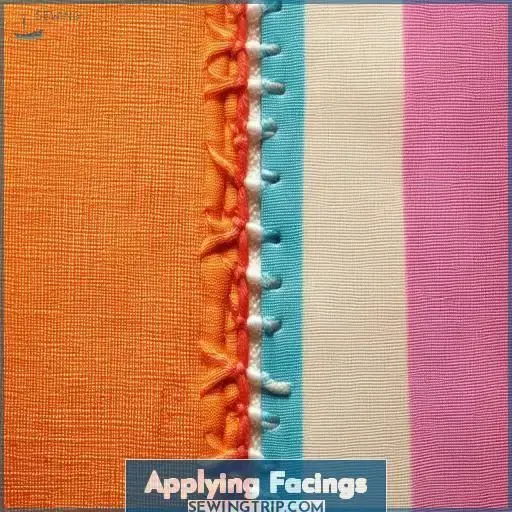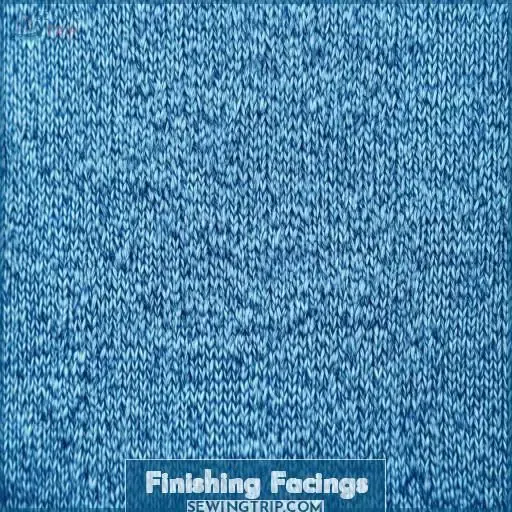This site is supported by our readers. We may earn a commission, at no cost to you, if you purchase through links.
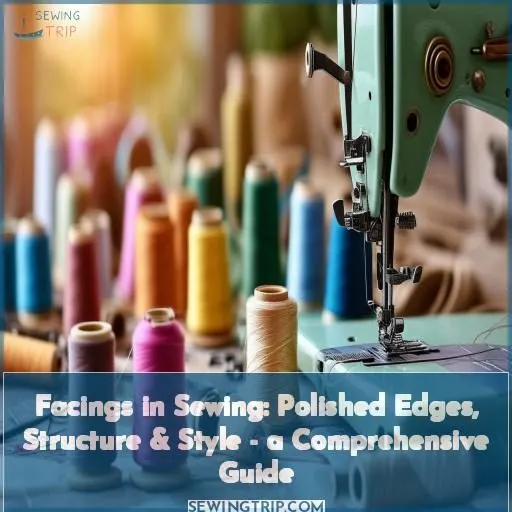
You’ll encounter different types – shaped facings precisely match edges, while bias facings allow flexibility for curves. Interfacing adds further structure and stability.
To apply facings, you’ll stay-stitch, pin right sides together, and sew the facing facing-side up before finishing raw edges neatly. Proper facing application takes some effort but adds that professional touch – and you’ll see how it elevates your sewing projects.
Table Of Contents
Key Takeaways
- Facings are like the secret sauce that transforms your garments from amateur hour to runway ready. Think of them as a hidden layer of fabric that neatly conceals those unsightly raw edges and adds shape to areas like necklines and armholes. It’s like giving your garment a little structural support while dressing it up for success.
- Imagine trying to sew a curve-hugging dress with no facings – yikes! That’s a recipe for stretchy disaster. But with a trusty bias facing? It’ll wrap around those tricky curves like a pro, ensuring your hard work doesn’t go south halfway through date night.
- You know that satisfying feeling when you nail a clean finish? That’s what facings are all about. It’s the seamstress’s version of putting on the chef’s kiss – a polished, professional look that’ll make you beam with pride every time you slip on that handmade gem.
- Here’s a little sewing secret: facings are the unsung heroes that can elevate even the simplest pieces. That basic tee? Add a pop of contrast facing for a stylish peek-a-boo effect. Those plain pajama pants? A pretty piped facing adds a luxe touch. It’s like giving your creations a little makeover without going overboard.
What is Facing in Sewing?
What is facing in sewing? Facing is a technique where a separate piece of fabric is attached to the raw edges of a garment opening, such as necklines or armholes, to finish and stabilize these areas.
What is a Facing?
You’ve likely seen facings before, even if you didn’t recognize them. A facing is simply a strip of fabric turned inward to finish a raw edge on your garment. It’s cut from the same fabric and grain direction as the garment section it will finish.
Facings are sewn right onto the neckline, armhole, or hem – transforming those raw edges into a polished, clean finish. They’re an essential pattern piece that gives your garment a professional look while preventing stretching or fraying along the edges.
With the facing fabric neatly encasing those exposed areas, your hard work shines through.
Purpose of Facings
Facings play a significant role in sewing, providing a polished, professional finish to garment edges and openings. Their primary purposes are to conceal raw edges, add structure to areas like necklines and armholes, and enhance the overall appearance by creating crisp, smooth lines.
Finishing Raw Edges
You’ll use facings to conceal unsightly raw edges on necklines, armholes, and other openings, giving your garments a flawless finish. The right placement and fabrics like bias tape guarantee your facings lay flat, preventing fraying while accentuating style lines. Whether using pinking shears or a facing interfacing, polished raw edges elevate construction quality.
Providing Structure
Facings provide crucial structure. The facing shape reinforces edges against stretching while the facing fabric adds body.
Interfacing supports this purpose. Its rigidity maintains the facing shape, preventing distortion.
Bias facing cuts around curves allow flexibility without compromising support. This is essential for finishing necklines and other complex edges in garment construction.
Proper seam finishes and interfacing complete the structural role of facings.
Enhancing Appearance
You’ll enhance your garment’s appearance by carefully selecting fabrics with colors, textures, and patterns that complement the overall design. A facing’s fabric choice affects:
- Fabric selection: Coordinate colors to create depth or harmony
- Texture contrast: Combine matte facings with lustrous fabrics
- Pattern matching: Guarantee facing patterns align with garment sections
Types of Facings
There are three main types of facings you’ll encounter in sewing: shaped facings, which are separate pieces cut to the same shape and grain as the garment edge; extended facings, which are extensions of the garment itself folded back along the edge; and bias facings, narrow strips of lightweight fabric cut on the bias to smoothly navigate curves.
Shaped Facings
Shaped facings are separate pattern pieces cut from the same fabric and grain as the garment area they’ll finish. They precisely match curves and angles, ensuring a polished fit along necklines, armholes, or openings. These facings provide structure while preventing stretching or gaping:
| Facing Material | Facing Placement | Facing Shape |
|---|---|---|
| Garment Fabric | Neckline | Curved |
| Cotton | Armhole | Angled |
| Sheer | Peek-a-boo | Unique |
Extended Facings
You’ll love extended facings – they create an invisible finish by using the garment’s fabric itself! Just match the facing pattern to the main piece, choose a lightweight, drapey fabric, and sew with a narrow seam allowance. When folded inward, extended facings effortlessly blend into the garment for a flawless, seamless look.
Bias Facings
For curved edges or when a facing needs flexibility, you’ll opt for bias facings. These narrow strips are cut on the bias, giving them stretch. Bias facings mold effortlessly around tricky necklines or armholes. Alternatives like bias tape make quick work of facings. Contrasting colors add visual punch through color blocking, while decorative topstitching highlights pattern matching.
Interfacing for Facings
You’ll want to carefully consider the type of interfacing to use for your facings, as it plays a key role in providing structure and preventing stretching or sagging. Woven, non-woven, sew-in, and fusible interfacings are available options, each with its own benefits based on the fabric weight, drape, and desired result for the garment.
Types of Interfacing
For facings, you’ll want to choose the right interfacing. Fusible interfacing bonds to the fabric with heat. Non-fusible interfacing gets sewn onto the facing. Woven interfacing provides stability and shape, while knit interfacing is stretchy and flexible. Sheer interfacing is lightweight and invisible – perfect for delicate fabrics.
Benefits of Interfacing
You’ll want to interface your facings for several reasons. It:
- Stabilizes the fabric, preventing stretching or distortion
- Supports the facing’s shape and structure
- Provides a crisp, smooth finish
- Helps facings last longer without sagging or wrinkling
The right interfacing can transform a facing from flimsy to polished. You have options too:
- Woven for crisper fabrics
- Knit for stretch fabrics
- Fusible for quick application
Matching your interfacing to the facing fabric is key.
Applying Facings
Prior to stitching the facing to your garment, stay-stitch the neckline or armhole to prevent stretching.
Then pin the facing to the garment with right sides together, making sure to align seams and notches precisely.
When stitching the facing to the garment section, work with the facing side facing up. This will allow for better visibility and control during the sewing process.
Preparation Steps
After interfacing, it’s time to prep your facing materials. Confirm pattern accuracy by transferring markings and carefully cutting along the grain line. Leave seam allowances intact and stay-stitch garment edges to prevent stretching. The table below illustrates key prep steps:
| Step | Purpose |
|---|---|
| Transfer markings | Align facings precisely |
| Cut along grain | Prevent distortion |
| Leave seam allowance | Allow for attaching facing |
| Stay-stitch edges | Maintain shape during sewing |
Stitching Techniques
To stitch facings, consider fabric weight and stretch—bias facings work great for curves.
Use stay-stitching to stabilize edges before pinning facing to garment right sides together, aligning notches.
Try facing variations like applying bias binding for an alternative finish or using lightweight interfacing to add structure.
Careful stitching and grading seam allowances prevents bulk and aids a crisp, professional result.
Grading and Clipping
After stitching the facing to the garment, you’ll need to grade and clip the seam allowances. Grade (trim) the bodice seam allowance to about half its width. Then, clip the curved areas like necklines or armholes to help the facing turn smoothly. Different facing types, interfacing options, and facing fabrics impact bulk reduction techniques.
Finishing Facings
Once you’ve applied the facing to the garment, you’ll need to finish the raw edges to prevent fraying and give a polished look. Secure the facing in place by tacking it at shoulder seams or understitching, and consider using a lightweight fabric for the facing to reduce bulk.
Edge Treatments
To give facings a polished finish, try these edge treatments:
- Finish raw edges with bias tape or pinking shears
- Apply a seam finish like zigzag or overlock stitching
- Use tacking stitches for inconspicuous securement
- Opt for lightweight fusible interfacing to prevent facings from rolling
Securing Facings
You’ll want to tack or slip stitch the facing to secure it in place once attached to the garment. Don’t skip understitching – it keeps the facing from rolling out. For a sturdy, professional finish, consider top stitching the facing’s edge or using neat hand stitches to invisibly secure it.
Reducing Bulk
You’ll also want to reduce bulk from facings. Consider using a lighter-weight fabric for the facing itself to minimize excess layers. Additionally:
- Trim seam allowances as much as possible
- Grade larger seam allowances down
- Use smaller seam allowances
- Interface only the necessary areas
Carefully controlling fabric weights and seam allowances provides a clean, crisp finish without unsightly bulk.
Frequently Asked Questions (FAQs)
What is a facing in sewing?
You may think facings are just optional trims, but they’re essential seam finishes that prevent fraying and maintain a garment’s structure. Simply put, a facing finishes a raw edge by folding fabric under, creating a clean finish and ensuring proper fit.
What is the difference between facing and interfacing?
Facing finishes and stabilizes raw fabric edges, while interfacing adds structure and shape behind the fabric. You’ll want to use both: facing for a polished outer appearance, and interfacing underneath for support and stability.
What is face in sewing?
You walk into your sewing room, fabric in hand, ready to tackle that new project. But hold on – what’s that essential step for a refined finish? It’s facing, the secret to transforming raw edges into sleek, professional-looking garments. A well-executed facing is the hallmark of skilled craftsmanship.
What is the difference between facing and lining?
The key difference is that a facing covers just the edge of a garment, while a lining covers the entire inside. Facings finish raw edges and provide structure, whereas linings add warmth and a smooth inner surface against your skin.
How do you determine facing fabric amount?
To determine facing fabric amount, measure the neckline/armhole opening, add seam allowances, and round up to the nearest 1/4 yard. For curved edges, you’ll need extra fabric cut on the bias.
Whats the difference between binding and facing?
While a facing finishes a raw edge, a binding encloses it. Facings are sewn within garments, while bindings wrap around an edge. Facings lend structure; bindings offer decoration. You choose facings for necklines and armholes, bindings for quilts or decorative trim.
Can facings be decorative elements on garments?
Yes, facings can add a decorative flair while finishing edges. From contrasting colors to unique fabric choices like lace or brocade, they’re an artistic canvas to express your creativity with visually striking results.
Are facings suitable for knit fabric garments?
Yes, facings are suitable for knit garments. You’ll need to use a stretchy interfacing, like knit or tricot fusible, when stabilizing the facing area. For best results, cut the facing on the crossgrain and avoid bulk by grading seam allowances.
How do you finish facing edges neatly?
To finish facing edges neatly, consider trimming with pinking shears, binding with bias tape, or serging for a clean, professional look. Understitching also helps keep the facing rolled inward. A quality finishing touch makes all the difference.
Conclusion
Mastering facings in sewing may seem like a minor detail, but it’s truly the cherry on top for a professional finish.
You’ve invested time and effort into your project – don’t let unsightly raw edges or sloppy necklines diminish its quality.
With strategic facing application, including precise stitching, clipping curves, and securing edges neatly, your garments will exhibit that polished, structured appearance every seamstress covets.
Embrace facings as the bridge between home-sewn and high-end garments.

